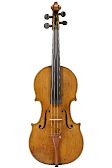Antonio Gragnani
1728–1810One of the superlative violinmakers of the Tuscan school, Antonio Gragnani, set up his workshop in the harbor town of Livorno after studying in Florence, where Giovanni Battista Gabrielli had worked at the time. Although the Stainer model still prevailed in Florence during that period, Gragnani developed his own personal style. His work is partly reminiscent of Amati, and especially of Stradivari, but his instruments are anything but copies of these masters’ work. Gragnani’s style is highly distinctive, and his instruments display excellent craftsmanship. Occasionally, he used whalebone, a very strong material, rather than wood for the purfling blacks, perhaps because whalebone was easily obtainable in a port town like Livorno. Makers in the Netherlands occasionally used whalebone as well, but in Italy, Gragnani is the only craftsman to have done so. The scrolls with elongated pegboxes are also typical features of Gragnani’s lutherie. Along with the oval shape of the volutes, they give his instruments their distinctive appearance. Mostly violins and a few violas are known to have remained of Gragnani’s work today. In addition to affixing the maker’s label inside the body, the master brand stamped his initials on various parts of the instrument, mostly on the ribs near the end button.

